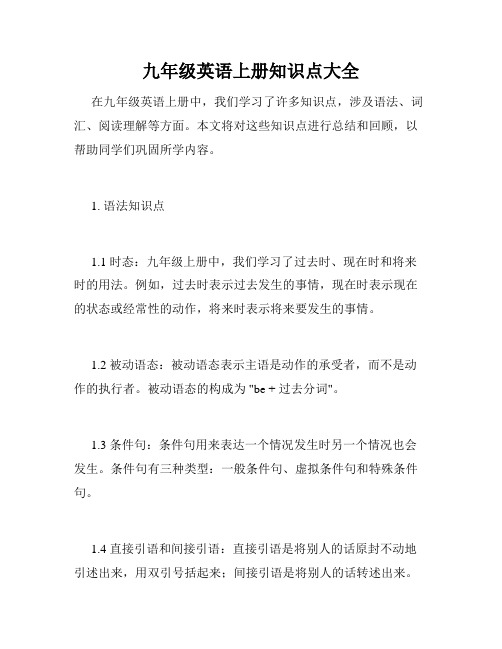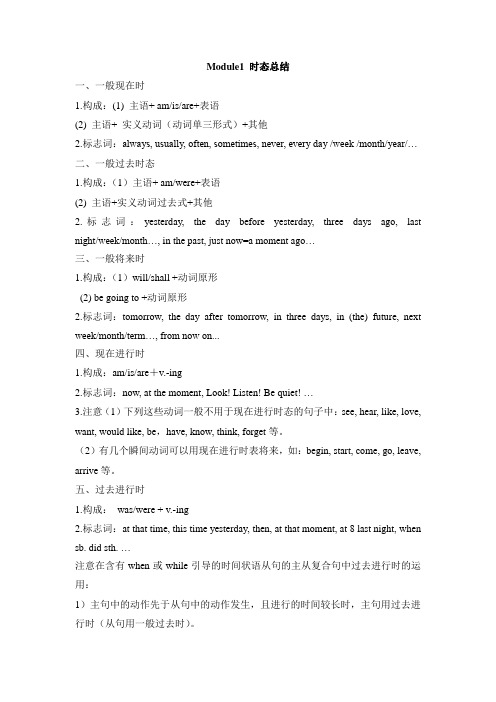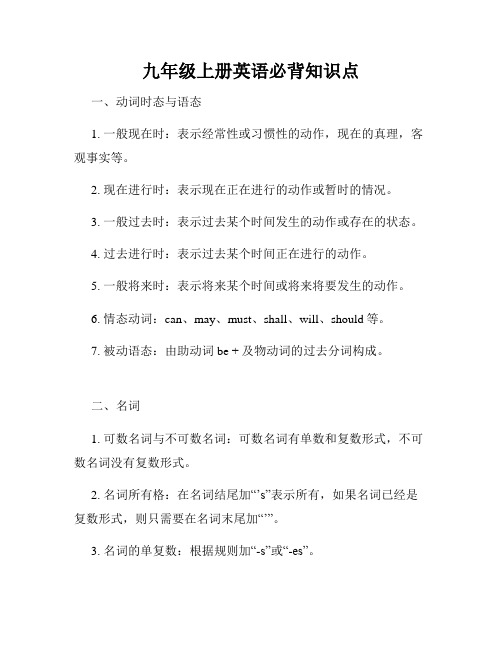九年级英语(上册)语法专题——6大时态
- 格式:doc
- 大小:51.00 KB
- 文档页数:5

九年级英语上册知识点大全在九年级英语上册中,我们学习了许多知识点,涉及语法、词汇、阅读理解等方面。
本文将对这些知识点进行总结和回顾,以帮助同学们巩固所学内容。
1. 语法知识点1.1 时态:九年级上册中,我们学习了过去时、现在时和将来时的用法。
例如,过去时表示过去发生的事情,现在时表示现在的状态或经常性的动作,将来时表示将来要发生的事情。
1.2 被动语态:被动语态表示主语是动作的承受者,而不是动作的执行者。
被动语态的构成为 "be + 过去分词"。
1.3 条件句:条件句用来表达一个情况发生时另一个情况也会发生。
条件句有三种类型:一般条件句、虚拟条件句和特殊条件句。
1.4 直接引语和间接引语:直接引语是将别人的话原封不动地引述出来,用双引号括起来;间接引语是将别人的话转述出来。
在转述时,需要根据语法要求对动词、代词、时态等进行相应的转换。
2. 词汇知识点2.1 同义词和反义词:同义词是指意义相近或相同的词语,反义词则是指意义相反的词语。
通过学习同义词和反义词,可以丰富词汇,提高表达能力。
2.2 词汇搭配:词汇搭配是指某些词语之间常常会搭配在一起使用。
例如,"make a decision"、"take a shower"等。
学习这些搭配可以帮助我们更准确地表达意思。
2.3 词义辨析:有时候两个词语的意思相似,但用法不同。
学习这些词义辨析可以避免在表达时使用错误的词语。
3. 阅读理解知识点3.1 主旨大意题:主旨大意题要求从文章中归纳出作者想要传达的核心信息。
3.2 细节题:细节题要求根据文章中的具体信息进行回答。
3.3 推理题:推理题要求根据文章中的线索进行推断,并做出合理的判断。
3.4 词义猜测题:词义猜测题要求根据上下文和线索猜测生词的意思。
4. 写作知识点4.1 书信写作:九年级上册中,我们学习了如何写一封书信,包括信的格式、语气和内容等。

Module1 时态总结一、一般现在时1.构成:(1) 主语+ am/is/are+表语(2) 主语+ 实义动词(动词单三形式)+其他2.标志词:always, usually, often, sometimes, never, every day /week /month/year/…二、一般过去时态1.构成:(1)主语+ am/were+表语(2) 主语+实义动词过去式+其他2.标志词:yesterday, the day before yesterday, three days ago, last night/week/month…, in the past, just now=a moment ago…三、一般将来时1.构成:(1)will/shall +动词原形(2) be going to +动词原形2.标志词:tomorrow, the day after tomorrow, in three days, in (the) future, next week/month/term…, from now on...四、现在进行时1.构成:am/is/are+v.-ing2.标志词:now, at the moment, Look! Listen! Be quiet! …3.注意(1)下列这些动词一般不用于现在进行时态的句子中:see, hear, like, love, want, would like, be,have, know, think, forget等。
(2)有几个瞬间动词可以用现在进行时表将来,如:begin, start, come, go, leave, arrive等。
五、过去进行时1.构成:was/were + v.-ing2.标志词:at that time, this time yesterday, then, at that moment, at 8 last night, when sb. did sth. …注意在含有when或while引导的时间状语从句的主从复合句中过去进行时的运用:1)主句中的动作先于从句中的动作发生,且进行的时间较长时,主句用过去进行时(从句用一般过去时)。

九年级上册英语必背知识点一、动词时态与语态1. 一般现在时:表示经常性或习惯性的动作,现在的真理,客观事实等。
2. 现在进行时:表示现在正在进行的动作或暂时的情况。
3. 一般过去时:表示过去某个时间发生的动作或存在的状态。
4. 过去进行时:表示过去某个时间正在进行的动作。
5. 一般将来时:表示将来某个时间或将来将要发生的动作。
6. 情态动词:can、may、must、shall、will、should等。
7. 被动语态:由助动词be + 及物动词的过去分词构成。
二、名词1. 可数名词与不可数名词:可数名词有单数和复数形式,不可数名词没有复数形式。
2. 名词所有格:在名词结尾加“’s”表示所有,如果名词已经是复数形式,则只需要在名词末尾加“’”。
3. 名词的单复数:根据规则加“-s”或“-es”。
1. 人称代词:I、you、he、she、it、we、they等。
2. 物主代词:mine、yours、his、hers、its、ours、theirs等。
3. 反身代词:myself、yourself、himself、herself、itself、ourselves、yourselves、themselves等。
4. 指示代词:this、that、these、those等。
5. 疑问代词:who、whose、whom、what、which等。
6. 关系代词:that、which、who、whom、whose等。
四、形容词与副词1. 形容词的用法:修饰名词时放在名词前面,修饰不定代词时放在后面。
2. 形容词比较级与最高级:一般在形容词后面加“-er”表示比较级,加“-est”表示最高级。
3. 形容词的位置:一般在连系动词后面作表语,也可用于作定语或宾补。
4. 副词的用法:修饰动词、形容词或其他副词。
1. 地点介词:in、on、at、under、over、below、above等。
2. 时间介词:in、on、at、before、after、during等。

译林版九年级英语上册语法知识点总结1. 时态1.1 一般现在时- 表示经常性或惯性的动作。
- 表示普遍真理或事实。
1.2 一般过去时- 表示过去发生的事情。
- 表示过去惯性的动作。
1.3 一般将来时- 表示将来会发生的事情。
- 表示将来计划或打算做的事情。
2. 语态2.1 被动语态- 表示动作的承受者。
- 结构:be + 过去分词。
3. 情态动词3.1 情态动词表能力- can, could3.2 情态动词表可能性- may, might, must, can't3.3 情态动词表建议- should, should've, would, would've4. 句子结构4.1 简单句- 包含一个主语和一个谓语。
4.2 复合句- 包含两个或两个以上的简单句。
- 连接词:and, but, or, because, so, if, unless等。
4.3 并列句- 两个或两个以上的句子用并列连词连接。
- 并列连词:and, but, or等。
5. 疑问句5.1 一般疑问句- 是否疑问句:Do, Does, Did + 主语 + 谓语。
- 特殊疑问句:What, How, Why, Who, When, Where等 + 主语 + 谓语。
5.2 选择疑问句- 提供两个或两个以上的选项。
- 结构:Do, Does, Did + 主语 + 谓语 + 选项。
5.3 否定疑问句- 在肯定句后加上否定词。
- 结构:Do, Does, Did + 主语 + 谓语 + 否定词。
6. 祈使句- 表示命令、请求或建议。
- 结构:动词原形 / 动词原形 + 宾语。
7. 代词7.1 人称代词- I, you, he, she, it, we, they。
7.2 物主代词- my, your, his, her, its, our, their。
7.3 反身代词- myself, yourself, himself等。

动词时态(教学设计)一、教学内容六种动词时态二、教学目标(一)复习六种时态的定义,构成规则(二)能正确的运用动词的三种时态三、重点难点(一)初中英语动词六种时态的定义、规则(二)初中英语动词六种时态的用法四、教学过程(一)动词的时态在英语中,由于谓语动词发生的时间不同,或表达不同时间存在的状态,谓语动词都要发生相应的变化,这些动词的形式就叫做动词的时态。
英语共有16种时态,现阶段学生已学习6种。
现以动词do为例,将这6种时态构成列表如下:①现在:一般现在时:①do ②does;现在进行时:am/is/are doing;现在完成时:has/have done②过去:一般过去时:did;过去进行时:was/were doing③将来:一般将来时:①am/is/are going to do ②will/shall do1.一般现在时:(1)构成:①动词原形②动词第三人称单数形式(2)形式:①be动词:肯定句:主语+am/is/are+表语(n./pron./adj.)eg:I am/I’m a student. You are/You’re a student. He is/He’s/She is/She’s a student.否定句:主语+am/is/are+not+表语(n./pron./adj.)eg:I am not/I’m not a student. You are not/You’re not/You aren’t a student.疑问句:Am/Is/Are+主语+表语(n./pron./adj.)eg:Am I a student? Are you a student? Is he/she a student? Is it an apple?②其它动词:肯定句:主语+动词原形/第三人称单数形式(+宾语)(+状语)eg:I/You/We/You/They study English every day.否定句:主语+don’t/doesn’t(第三人称单数)+动词原形(+宾语)(+状语)eg:I/You/We/You/They don’t study English every day.疑问句:Do/Does+主语+动词原形(+宾语)(+状语)eg:Do I/You/We/You/They study English every day?(3)用法:①表示经常发生的动作或现在存在的状态eg:I go to school every day except Sunday.除了星期日,我每天都上学。

万唯九年级英语知识点汇总一. 时态和语态1. Simple Present Tense 现在简单时态The Simple Present Tense is used to express habitual actions, general truths, and permanent situations.2. Present Continuous Tense 现在进行时态The Present Continuous Tense is used to describe actions that are happening at the moment of speaking.3. Simple Past Tense 过去简单时态The Simple Past Tense is used to talk about actions that happened at a specific time in the past.4. Past Continuous Tense 过去进行时态The Past Continuous Tense is used to describe actions that were in progress at a specific time in the past.5. Present Perfect Tense 现在完成时态The Present Perfect Tense is used to talk about actions that happened in the past but are still relevant to the present.6. Past Perfect Tense 过去完成时态The Past Perfect Tense is used to express an action that happened before a specific time in the past.7. Future Simple Tense 将来简单时态The Future Simple Tense is used to talk about actions that will happen in the future.8. Passive Voice 被动语态The Passive Voice is used when the subject of the sentence is acted upon by the verb.二. 语法1. Direct and Indirect Speech 直接引语和间接引语Direct speech is when we quote the exact words spoken by someone, while indirect speech is when we report what someone said without using their exact words.2. Relative Clauses 关系从句A relative clause is a type of subordinate clause that describes or provides more information about a noun.3. Reported Speech 被动语态Reported speech is used when we want to report what someone said in our own words.4. Conditionals 条件句Conditionals are sentences that express a condition and its result. There are different types of conditionals, including zero, first, second, third, and mixed conditionals.5. Modal Verbs 情态动词Modal verbs are auxiliary verbs that express necessity, possibility, ability, permission, and advice.三. 词汇和表达1. Synonyms 同义词Synonyms are words that have similar meanings.2. Antonyms 反义词Antonyms are words that have opposite meanings.3. Idioms and Phrases 成语和短语Idioms and phrases are expressions that have a figurative meaning different from their literal meaning.4. Collocations 固定搭配Collocations are words that are commonly used together.5. Word Formation 词汇构词Word formation refers to the process of creating new words or forms of words.四. 阅读理解1. Skimming and Scanning 略读和查读Skimming is the process of quickly going through a text to get a general idea of its content, while scanning is the process of searching for specific information in a text.2. Inferencing 推理Inferencing is the process of using clues in a text to make educated guesses or draw conclusions.3. Note-taking 笔记Note-taking is the process of summarizing important information while reading or listening.4. Multiple Choice Questions 多项选择题Multiple choice questions require the reader to choose the correct option from a list of choices.五. 写作技巧1. Paragraph Structure 段落结构A well-structured paragraph consists of a topic sentence, supporting sentences, and a concluding sentence.2. Cohesion and Coherence 连贯性和一致性Cohesion refers to the use of linking words and phrases to connect ideas within a text, while coherence refers to the logical flow of ideas in a text.3. Descriptive Writing 描述性写作Descriptive writing is used to create a vivid picture in the reader's mind by using sensory details and figurative language.4. Argumentative Writing 议论文写作Argumentative writing is used to persuade the reader to adopt a certain point of view or take a specific action.5. Narrative Writing 叙事写作Narrative writing is used to tell a story or recount a sequence of events.六. 口语表达1. Greetings and Introductions 问候和介绍Common greetings and introductions used in everyday conversations.2. Expressing Opinions 表达观点Useful phrases for expressing opinions and giving reasons in discussions or debates.3. Making Suggestions 提出建议Phrases and expressions for making suggestions in a polite and respectful manner.4. Asking for and Giving Directions 问路和给路Vocabulary and phrases for asking for and giving directions when navigating in a city.5. Making Apologies and Excuses 道歉和找借口Phrases and expressions for apologizing and making excuses in different situations.以上是万唯九年级英语知识点的汇总,包括时态和语态、语法、词汇和表达、阅读理解、写作技巧以及口语表达。
初中英语九种时态和基本从句总结初中英语九种基本时态总结语法知识是在掌握一定量的单词和短语的基础上才能获得的。
因此,初中英语九种基本时态和含有不复杂的状语从句及宾语从句的复合句是初三学生学习的重点也是语法学习的难点。
以下是英语学习方法之九种基本时态分析。
一、一般现在时。
概念: 表示经常发生的动作或经常存在的状态。
常和 always , often , usually , sometimes , every day 等表时间的状语连用。
如:1) I go to school every day . 我每天都去学校。
(表经常)2) He is always like that . 他总是那样。
(表状态)构成: 1) 主语+ be (am / are / is ) +……2) 主语 + 实义动词+ …二、一般过去时。
概念: 1) 表示过去某个时间发生的动作或存在的状态.常和表示过去的时间状语连用. 如: yesterday , last week , in 1998 , two days ago等.如: I went to a movie yesterday. 我昨天去看了一场电影.2) 也可表示过去经常或反复发生的动作.如: He always went to work by bike last week.构成: 1) 主语+ be (was / were ) +……2) 主语 + 实义动词过去式 +三、现在进行时。
概念: 表示现在(说话瞬间)正在进行或发生的动作.如: He is singing.They are watching TV now.构成: 主语 + 助动词be(am/are/is) + 动词-ing形式构成.四、过去进行时。
概念: 表示过去某一时刻或某一段时间正在进行的动作. 这一特定的过去时间除了有上下文暗示外,一般用时间状语来表示.如: 1) ---What were you doing?---I was jumping.2) ---What was the boy doing when the UFO arrived?---He was sleeping.构成: 主语 + 助动词be(was/were) + 动词-ing形式构成.五、一般将来时。
九年级上册英语知识点汇总本文将汇总九年级上册英语的知识点,方便同学们进行学习和复习。
以下是各个模块的知识点总结:一、语法知识1. 一般现在时:表示经常性的动作、习惯或客观事实。
2. 一般过去时:表示过去发生的动作或状态。
3. 现在进行时:表示现在正在进行的动作。
4. 过去进行时:表示过去某个时刻或一段时间内正在进行的动作。
5. 一般将来时:表示将来发生的动作或状态。
6. 情态动词:表示能力、可能性、许可、意愿等。
7. 被动语态:表示动作的接受者重要于执行者。
8. 直接引语和间接引语:转述别人说过的话。
9. 名词性从句:用作主语、宾语、表语或同位语的从句。
10. 定语从句:修饰名词或代词的从句。
二、词汇知识1. 动词短语:由动词和副词或介词组成的短语。
2. 名词性短语:由名词、代词或动名词构成的短语。
3. 形容词性短语:由形容词或副词构成的短语。
4. 副词性短语:由副词构成的短语。
5. 介词短语:由介词和名词、代词或动名词构成的短语。
6. 连词短语:由连词构成的短语。
三、听力技巧1. 根据听到的对话内容选择正确的答案。
2. 根据听到的问题选择正确的答案。
3. 根据听到的对话或独白填写所缺的信息。
四、阅读技巧1. 根据短文内容选择正确的答案。
2. 根据短文内容判断句子正误。
3. 根据短文填写所缺的词语。
4. 根据短文回答问题。
五、写作技巧1. 根据给定的提示写一篇短文。
2. 根据给定的图片写一篇短文。
3. 根据所给的问句写一篇短文。
六、口语表达1. 日常生活用语:问候、道谢、邀请、购物等。
2. 交通、饮食、购物、旅行等场景中的口语表达。
3. 描述人物或事物的外貌、性格、习惯等。
七、阅读理解1. 根据短文内容选择正确的答案。
2. 根据短文内容判断句子正误。
3. 根据短文填写所缺的词语。
4. 根据短文回答问题。
八、短语和固定搭配1. 动词短语:例如:break up, carry out, put off等。
初中英语语法八大时态概述一、一般现在时 (Simple Present Tense)一般现在时用于描述常规性的行为、事实或真理。
常见的时间状语有:always(总是)、usually(通常)、often(经常)、sometimes(有时候)、never(永不)等。
例句:- I always go to school by bus.- She usually eats breakfast at home.- They often play football on weekends.- He sometimes helps his mother with the housework.- Cats never like water.二、一般过去时 (Simple Past Tense)一般过去时用于描述过去发生的事情或存在的状态。
常见的时间状语有:yesterday(昨天)、last week(上周)、two hours ago (两小时前)等。
例句:- I visited my grandparents yesterday.- She bought a new dress last week.- They watched a movie two hours ago.三、一般将来时 (Simple Future Tense)一般将来时用于描述将来要发生的事情或存在的状态。
常见的时间状语有:tomorrow(明天)、next month(下个月)、in a week(一周后)等。
例句:- I will go shopping tomorrow.- She is going to visit her friend next month.- They are going to have a party in a week.四、现在进行时 (Present Continuous Tense)现在进行时用于描述正在进行的动作。
初中英语9大时态+3大从句+70个核心句型九种基本时态一、一般现在时表示经常发生的动作或经常存在的状态。
常和always , often , usually , sometimes , every day等表时间的状语连用。
如:1) I go to school every day . 我每天都去学校。
(表经常)2) He is always like that . 他总是那样。
(表状态)构成:1) 主语+ be (am / are / is ) +……2) 主语+ 实义动词+ …二、一般过去时1) 表示过去某个时间发生的动作或存在的状态。
常和表示过去的时间状语连用。
如:yesterday , last week , in 1998 , two days ago等。
如:I went to a movie yesterday. 我昨天去看了一场电影。
2) 也可表示过去经常或反复发生的动作。
如: He always went to work by bike last week.构成:1) 主语+ be (was / were ) +……2) 主语+ 实义动词过去式+…三、现在进行时表示现在(说话瞬间)正在进行或发生的动作。
如:He is singing.They are watching TV now.构成:主语+ 助动词be(am/are/is) + 动词-ing形式构成四、过去进行时表示过去某一时刻或某一段时间正在进行的动作。
这一特定的过去时间除了有上下文暗示外,一般用时间状语来表示。
如:1) ---What were you doing?---I was jumping.2) ---What was the boy doing when the UFO arrived?---He was sleeping.构成:主语+ 助动词be(was/were) + 动词-ing形式构成.五、一般将来时表示将来某个时间要发生的动作或存在的状态,也表示将来经常或反复发生的动作。
九年级英语(上册)语法专题——6大时态复习(1)班别:_______________学生姓名:_______________组别号:_______________九年级英语(上册)语法专题——6大时态复习(2)班别:_______________学生姓名:_______________组别号:_______________二、反馈练习(题目中如有时态标志,请划出来。
)1)用所给单词的适当形式填空。
1.I____________(tell)himthenewsassoonasIseehim.2.Janeandherparents_____________(fly)akiteintheparklastFriday.3.They_____________(swim)intheriveratteno’clockyesterdaymorning.4.InordertowatchthenewsonTV,heoften_______________(finish)hishomeworkbefore7o’clock.5.Heruncle________________(teach)inthisschoolsince2002.6.Hismother_______________(get)upatsixo’clockandmadebreakfastforhim.7.Look!Mike______________(play)chesswithDavid.8.Myfatherisn’tathome.He_________________(go)towork.9.WhenIopenedthedoor,Mum_________________(cook)inthekitchen.10.Bettywillgoshoppingwithmeifit_________________(notrain)tomorrow.2)选择填空()1.–Wha t’sthatnoise?--Janeandhersister_________TV.A.havewatchedB.arewatchingC.watched()2.–There______aconcertthisevening.–Yeah.Excitingnews!A.aregoingtobeB.isgoingtobeC.isgoingtohave()3.IhopeTina_____tomybirthdaypartyontimenextWednesday.A.tocomeeC.willcome()4.Tom_____alotoffriendssincehecametoChinalastyear.A.madeB.makesC.hasmade()5.–Didyouseethetrafficaccidentyesterday?--Yes.IthappenedwhenI____pastthemuseum.A.walkB.amwalkingC.waswalking()6.–Haveyoureadthisbook?--Yes.I_____ittwoweeksago.A.isreadingB.havereadC.read()7.—Whereisyourfather?Wehaven’tseeneachotherforweeks.--___________.A.HehasbeentoAmerica.B.HehasgonetoEngland.C.HeisgoingtoAustralia.()8.Hetellsmethathisgrandpa______.A.dieB.deadC.hasdied()9.Doyouknowwhenthedoctor_______?Thesickpeoplefeelterrible.A.willarriveB.arrivesC.arrived()10.Iwillgivehimthemessageassoonashe______back.A.willcomeB.camees()11.Whenshe______thenewspaper,John_____asleep.A.read;wasfallingB.wasreading;fellC.read;fell()12.Idon’tknowifhe______thisterm.Ifhe_____,hewilldobetterinmaths.A.studieshard;studieshardB.willstudyhard;studieshardC.studieshard;willstudyhard()13.–I’msorryyouhavemissedthebus.It_____fiveminutesago.–Whatapity!A.wasleavingB.hasleftC.left()14.–Shallwegoshoppingnow?--Sorry,Ican’t.I_____myshirts.A.washB.washedC.amwashing()15.–Excuseme.Lookatthesign:Noparking!--Sorry,I_____it.A.haven’tseenB.didn’tseeC.don’tsee()16.–WhendidyouborrowtheEnglishstorybook?--Iborroweditlastweek.I____itforaweek.A.hadB.havekeptC.haveborrowed()17.MyfriendLilyknowsmyhometownverywellbecauseshe____theremanytimeswithme.A.hasgoneB.hadbeenC.hasbeen()18.JackhasstudiedChineseinthisschool____theyearof2000.AsinceBinCon ()19._____you_____thetextyet?Yes,we_____ittwohoursago.A.Did;copy;hadB.Have;copied;haveC.Have;copied;did()20."He____todrawhorsesalready.""When____helearn?”."Lastyear."A.haslearned;didB.learned;didC.haslearned;has()21.Thesun__intheeastand__inthewest.A.rose;sunkB.rises;sinksC.rise;sink()22.Iamsorrythatyouhavemissedthetrain.It__tenminutesago.A.leftB.leavesC.willleave()23.Look!Theboystudentsare_______footballwhilethegirlsare_______.A.playing,danceB.playing,dancingC.play,dancing()24.He___finishedhishomeworkyet.A.doesn’t B.haven’t C.hasn’t()25.Theoldman______Chinaseveraltimesinthepast10years.A.hasbeentoB.wenttoC.goesto()26.He___hishomefortenyears.A.hasleftB.wasawayfromC.hasbeenawayfrom()27.JackhasstudiedChineseinthisschool_____theyearof2000.A.sinceB.inC.on ()28.–Haveyougonetoseethedoctor?--No,butI________.A.didn’tB.amgoingtoC.haven’t()29.Iwon’tforgetmyteacherbecauseshe_____sokindtomesinceIcametothisschool.A.hasbeenB.willbeC.was()30.–Badluck!It’stoolate!--Itdoesn’tmatter.Themovie____foronlyafewminutes.Youcan’tmissit.A.hasbeganB.hasbeenonC.began3)完成句子1.他哥哥通常骑单车上学。
Hisbrotherusually__________________________________________________________bybike.2.未来家会更舒服。
Home__________________________________________________morecomfortableinthefuture.3.天暖和了,我脱去了大衣。
Itwaswarm,soI____________________________________________________________mycoat.4.Mrs.Black经常在英语上帮助我们。
Mrs.Blackoften__________________________________________________________ourEnglish.5.电影上映半个钟了。
Themovie______________________________________________________________halfanhour.6.不要和她说话,她正在开车。
Don’ttalktoher,she____________________________________________________________now.7.老师来家访的时候,他正在看电视。
He_____________________________________________________whentheteachercametovisit.8.Jim在休假,他到Italy去了。
Jimisonholiday.He_____________________________________________________________Italy.9.我到达时Jane正在等我。
Jane______________________________________________________________mewhenIarrived.10.你能告诉我这本书你借了多久了吗?Couldyoutellmehowlong__________________________________________________thebook?。